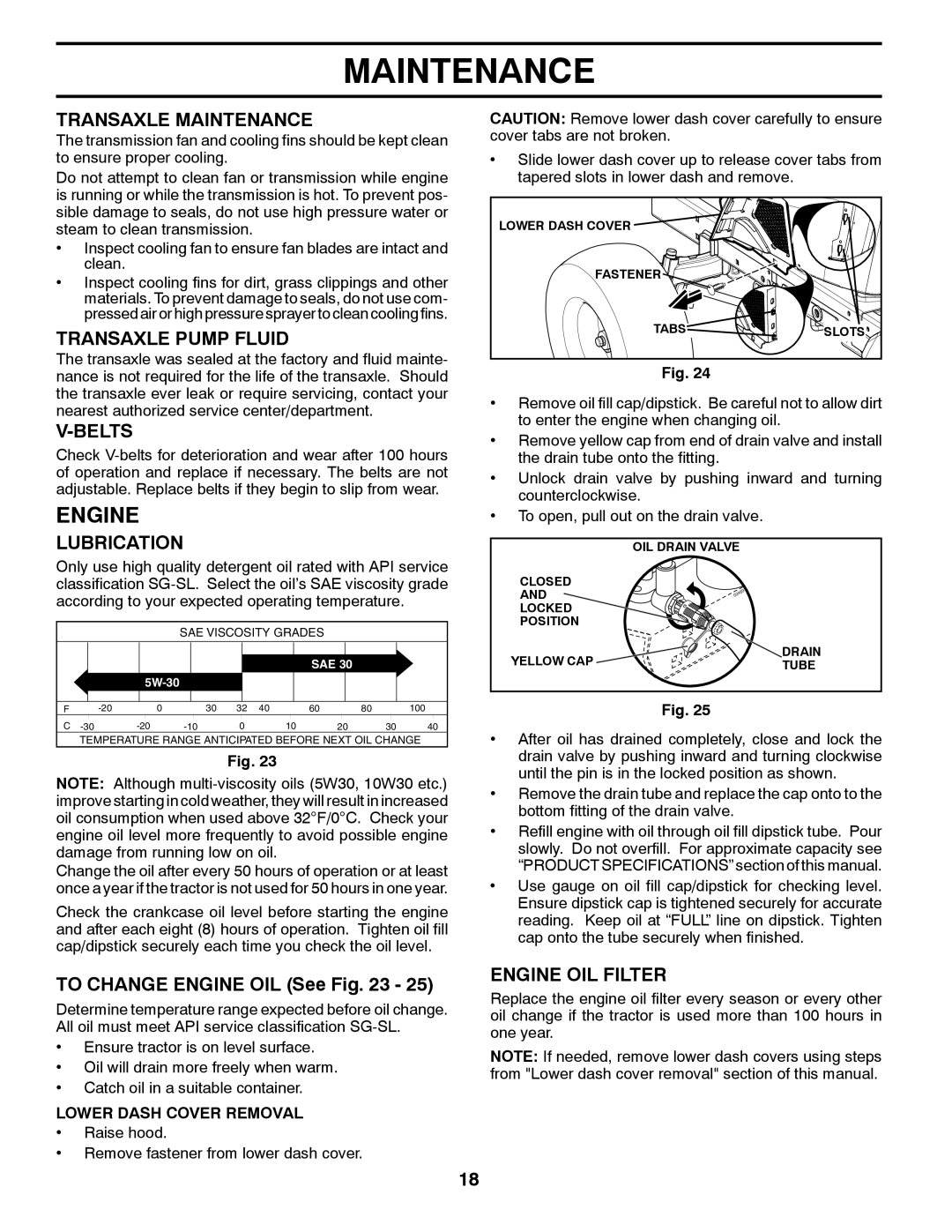
MAINTENANCE
TRANSAXLE MAINTENANCE
The transmission fan and cooling fins should be kept clean to ensure proper cooling.
Do not attempt to clean fan or transmission while engine is running or while the transmission is hot. To prevent pos- sible damage to seals, do not use high pressure water or steam to clean transmission.
•Inspect cooling fan to ensure fan blades are intact and clean.
•Inspect cooling fins for dirt, grass clippings and other materials. To prevent damage to seals, do not use com- pressed air or high pressure sprayer to clean cooling fins.
TRANSAXLE PUMP FLUID
The transaxle was sealed at the factory and fluid mainte- nance is not required for the life of the transaxle. Should the transaxle ever leak or require servicing, contact your nearest authorized service center/department.
V-BELTS
Check
ENGINE
LUBRICATION
Only use high quality detergent oil rated with API service classification
SAE VISCOSITY GRADES
|
|
|
|
|
|
|
|
|
| SAE 30 |
|
|
|
|
|
|
|
|
|
|
|
|
|
| |
|
|
|
|
|
|
|
|
|
|
|
|
|
F | 0 |
|
| 30 32 40 |
| 60 | 80 | 100 | ||||
C | 0 | 10 | 20 | 30 | 40 | |||||||
TEMPERATURE RANGE ANTICIPATED BEFORE NEXT OIL CHANGE
Fig. 23
NOTE: Although
Change the oil after every 50 hours of operation or at least once a year if the tractor is not used for 50 hours in one year.
Check the crankcase oil level before starting the engine and after each eight (8) hours of operation. Tighten oil fill cap/dipstick securely each time you check the oil level.
TO CHANGE ENGINE OIL (See Fig. 23 - 25)
Determine temperature range expected before oil change. All oil must meet API service classification
•Ensure tractor is on level surface.
•Oil will drain more freely when warm.
•Catch oil in a suitable container.
LOWER DASH COVER REMOVAL
•Raise hood.
•Remove fastener from lower dash cover.
CAUTION: Remove lower dash cover carefully to ensure cover tabs are not broken.
•Slide lower dash cover up to release cover tabs from tapered slots in lower dash and remove.
LOWER DASH COVER |
|
FASTENER |
|
TABS | SLOTS |
Fig. 24
•Remove oil fill cap/dipstick. Be careful not to allow dirt to enter the engine when changing oil.
•Remove yellow cap from end of drain valve and install the drain tube onto the fitting.
•Unlock drain valve by pushing inward and turning counterclockwise.
•To open, pull out on the drain valve.
| OIL DRAIN VALVE | |
CLOSED |
| |
AND |
| |
LOCKED |
| |
POSITION |
| |
YELLOW CAP | DRAIN | |
TUBE | ||
|
Fig. 25
•After oil has drained completely, close and lock the drain valve by pushing inward and turning clockwise until the pin is in the locked position as shown.
•Remove the drain tube and replace the cap onto to the bottom fitting of the drain valve.
•Refill engine with oil through oil fill dipstick tube. Pour slowly. Do not overfill. For approximate capacity see “PRODUCT SPECIFICATIONS” section of this manual.
•Use gauge on oil fill cap/dipstick for checking level. Ensure dipstick cap is tightened securely for accurate reading. Keep oil at “FULL” line on dipstick. Tighten cap onto the tube securely when finished.
ENGINE OIL FILTER
Replace the engine oil filter every season or every other oil change if the tractor is used more than 100 hours in one year.
NOTE: If needed, remove lower dash covers using steps from "Lower dash cover removal" section of this manual.
18
